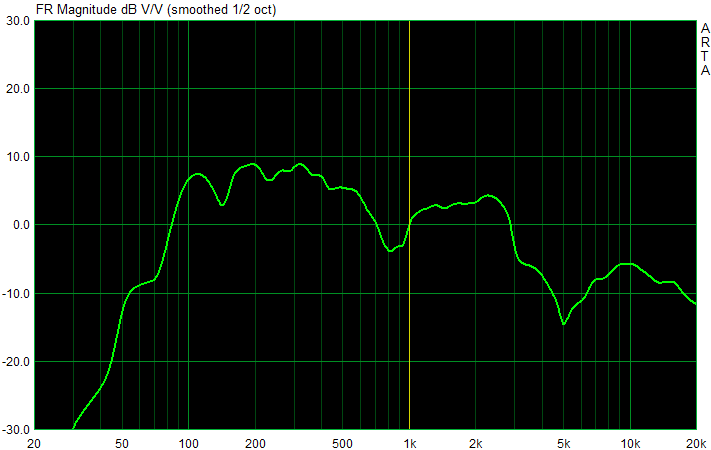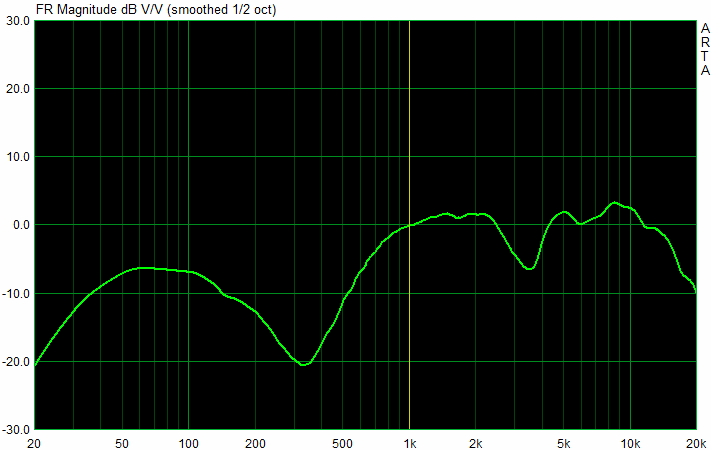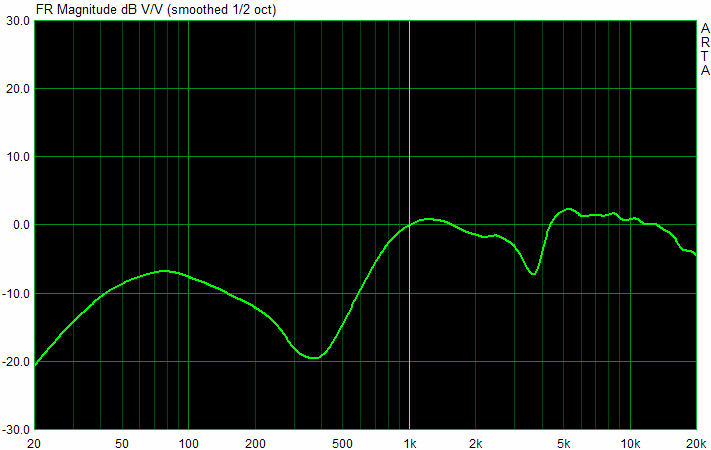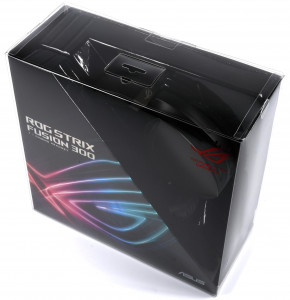Microphone
The fold-out microphone is conditionally flexible, but it is difficult to put it in an optimal position and move it to stay there. You can switch it off, only mechanically it goes through the high folding. However, one does not want to do the sharpening and knob noises up to the switching point to your counterpart. The environment is reasonably audible and sensitive is nevertheless different.

Microphone measurement and sound check
First, we measure the real frequency range of the microphone to meet readers' feedback. For this we use our measuring room again, but we virtually reverse the process. Of course, a true reciprocity calibration as a starting point exceeds our current possibilities and the effort far exceeds the benefits. That is why we have sought a compromise.
However, since we have a calibrated measuring microphone, a comparison measurement and the calculation of the differences can at least produce a curve that is easily usable for our purpose. So it is not the exact frequency response of the microphone, we would not presume that, but a meaningful approximation, which also underpins our subjective impression.
Measuring and audible, it can be seen that it is under approx. 100 Hz gives a stronger level drop, which is pronounced enough. The raising of the lower middle and the upper bass make the voice appear rather warm and full. The level difference of 22 dB (!) between 300 Hz and approx. 5 KHz then also explains why the sound image can be described as predominantly dull and rather musty. Sibilants? Hissing does not actually take place and the speech intelligibility just sizzled down the Empire State Building like a dewired lift to the final big bang. Too bad, we expected more here.

Headphone measurement
As we test, we have already explained in the basic article "Gaming Headsets: Myth, Truth and How we Test" very detailed and transparent, because with the usual audio-swirl of bass thunderstorms and high-pitched whips you can't really get any further. You have to be able to listen subjectively well and measure at the same time. Let us start with the latter.
If you look at the curve, the level drop of almost 20 dB at approx. 370 Hz the worry folds on the forehead. This is not the typical gamer bath, but a climb and descent of acoustic feelings par excellence, in which the bass area was also somewhat neglected in order to get a little more level resistance. The bottom line is that the curve looks more like a somewhat failed sound design and not a well-thought-out intention.

Switching to 7.1 Surround doesn't make it any better, but even more shrill thanks to a too pronounced reverberation. Incidentally, virtualization as such could not really convince.

Subjective listening experience
Let's also test subjectively what you have in the original on your ear. We used to operate the headset continuously for two days as usual at a source with a decent level, in order to give the one-game fanatics a chance.
Bass
Test the lowest bass in the subcontraoctave (16.4 Hz to 32.7 Hz) with a recording of Bach's Toccata and Fugue in D minor (19 and 25 Hz) and the Festival Overture 1812 by Tchaikovsky (10 Hz and 12.5 Hz). The same applies to the lower ranges of the contraoctothe (32.7 to 65.4 Hz). The big bass drum (kick drum), which in the U-music is a welcome companion and usually on approx. 55 to 60 Hz, this assessment will then be rounded off.
The bass is present, you have to attest to the headset. Even the low bass still succeeds in a modest way. Nevertheless, everything is somehow not pronounced and sovereign enough. It's all level-proof, but you'd have to adjust the equalizer if you wanted to force a slightly more natural rendition. It's just stupid that you would have to connect the headset analogously in order to be able to intervene by software at all. Asus doesn't provide anything for the USB solution (behind which we suspect a simple C-Media chip).
Gaming bass is still quite acceptable, but you probably don't want to listen to music with the headset. The settling behavior is average and the Urban Legend that you absolutely need 50 mm drivers to get a fat bass has been refuted by many good headphones and headsets. But that also leaves open the question of why more is not coming here. Bass is there, but brilliant or raven-black go differently.
The upper bass up to 150 Hz, in which also the Great Octave (65.4 to 130.8 Hz) is located, houses the basic language frequency of the male voice and decides very strongly on the true-to-life reproduction of male vocals.
This area also sounds rather unnatural, which adversely affects speech playback. Male vowels are already heavily circumcised in their volume, which is actually a great pity and instruments are deprived of their warm basic tone in this pitch. Then upstairs will sound cool and almost metallic. For most games, however, it is enough, only with film and music playback the more experienced listener has to be a little brave.
Frequency range
The lower middles (also basic tone range) are approx. 150 to 400 Hz. Together with the already mentioned upper bass, this area plays a very important role for the subjectively perceived heat or bass. Fullness of the sound. The basic language frequency of female voices can be found in this area.
Speaking of bravery… Female vocals are dying here the legendary heroic death of a lonely Valkyrie, because there is unfortunately nothing that could give a good and full base. Interestingly, this is rather less noticeable in games, although it is usually due to the sound material. At approx. 370 Hz the acoustic submersible has reached the lowest point of the sea of tears, because the level now goes, lying down, into the tonal orcus.
The upper mids between 400 Hz and about two KHz contain a mark at a KHz, which is still considered a reference for many measurements. Unfortunately, this is often noticeable with cheaper devices, as manufacturers often try to overemphasize this frequency. This area does not play an insignificant role in gaming either, and balanced playback contributes significantly to good spatial resolution.
The whole thing now rattles again and from about approx. 1 KHz, the level is again where you can still perceive it well. The stage is quite narrow and you have to replace the imitation leather with the textile ear pads, if you want to achieve at least some useful width. The location is still ok, but it's not grandiose here either. Sure, there are tons of worse gaming headsets, but for the proposed price, the question mark certainly won't go away.
There is no more to write about music here, because an otherwise well-positioned orchestra shrinks on the stage of the ROG Strix Fusion 300 so much spatially together, as if all the musicians were crowded together on the narrow 10-meter board of the indoor pool in Stand tub-egg and wait anxiously for the final jump.
High-pitched range
Between two and about 3.5 KHz, human hearing is most sensitive, especially since this area of the lower heights is responsible for the good overtone reproduction of the human voice. This frequency range is crucial for the recognition of a voice or instrument; in this context, one also speaks of the respective timbre.
It is precisely in this area that there is again an unfunny dent, which makes voice recognition much more difficult. Choral works mix into a single sauce and even in gaming more complex sound carpets get unsightly holes. Surely it would be painful if the Bolide cost less than 75 euros, but so? The timbre of almost all sources, whether instrument, voice or killer sound, is pale and without concise pep.
The middle heights (3.5 to six KHz) decide on the sound or failure of the speech reproduction as a whole, because the S- and hissing (Sibilants) fall into this range. The upper heights then reach up to approx. ten KHz to move into the super high tone.
The higher the scale swells into the acoustic sky, the shriller and more bleached the sound framework becomes. The Sibilants quickly become small, nasty saw teeth on the already stricken gamer nerve strands of Kevin-Klaus. The blow-out sounds of many instruments come to the fore too much, only shots sound somehow meaner and more fetid. Gaming-wise, this even fits when the protagonist hasn't fallen in love with an elf and tries to give her a motivating oath in the tip ear. That would come with brutal wind peaks and the good would be completely blown through and away.
In summary, gaming can work well if you don't play elven shavings with romantic music backdrops. The performance is generally not suitable for music, unless you are more blunt than an orc after two barrels of Grog and stand on combat sound from Aunt Helga's Partykeller-Ebay-Boxes. The orc lover, on the other hand, certainly enjoys the Haudrauf fight, because the parts even go nasty in places. Only a deep-seated sniper becomes nothing, because locating filigree sources becomes an insoluble quest. The part is not unusable, but not an acoustic fighting bull. Maximum office stallion from the accounting next door.
Summary and conclusion
 The 130 Euro RRP and a street price of approx. 110 Euros leave us in an annoying divisive situation. If the parts sound as good as haptics and material appearances at a high level in advance, then the ROG Strix Fusion 300 would be a voluminous recommendation.
The 130 Euro RRP and a street price of approx. 110 Euros leave us in an annoying divisive situation. If the parts sound as good as haptics and material appearances at a high level in advance, then the ROG Strix Fusion 300 would be a voluminous recommendation.
However, the tonal slump does not come from the sound chip, because analog it doesn't sound any better. The reasons are probably rather the built-in drivers and a sound design, which may have intended anything, but never achieved this.
Good and tight seat of a good mechanic against muddy music in the tunnel feeling. By the way, playing is still quite neat in comparison, if you are not exactly dependent on a good location. The Sniper of the world plays with good head-to-head, which means that the target group for the product tested today is more likely to be in the infantry or the tank driving.
For approx. 75 Euros could still be lived with it, but 35 Euro allowance for a red LED lighting and an extra software to be installed? Such bargains don't even dare VW on their sheer sprawling surcharge list. Which is not a non-purchase recommendation, but we are already quite disappointed. When unpacking, it all looked really good…
































Kommentieren